Vermont Education Committee reviews new school standards and construction funding proposals
April 01, 2025 | Ways & Means, HOUSE OF REPRESENTATIVES, Committees, Legislative , Vermont
This article was created by AI summarizing key points discussed. AI makes mistakes, so for full details and context, please refer to the video of the full meeting. Please report any errors so we can fix them. Report an error »

During a recent meeting of the Vermont House Ways and Means Committee, significant discussions centered on educational funding and standards, raising important questions about the future of public and independent schools in the state.
One of the primary concerns raised was the allocation of funds to school districts that have historically underutilized their tax capacity. A committee member expressed apprehension that the proposed new standards—focused primarily on graduation rates and class size—may not provide sufficient guidance on how additional funding should be applied. This concern highlights the need for clarity in how financial resources are directed to ensure they effectively support educational outcomes.
The committee also examined the language surrounding the classification of schools as "small by necessity." Questions arose regarding whether this designation applies to both public and independent schools, with members noting the ambiguity in the current wording. This uncertainty could impact how schools are funded and regulated, particularly for those that may struggle to meet new size standards.
Another key topic was the proposed rule requiring independent schools accepting public tuition to comply with minimum class size standards. Some members questioned the implications of this rule, particularly for schools that may not currently accept public funds but intend to in the future. The discussion underscored the importance of ensuring that all schools receiving public money adhere to the same educational standards, regardless of their current status.
The committee also touched on aspirational goals for school size, with a proposal that each public school serving grades 6 through 12 should aim for a minimum average daily membership of 450 students. While this is currently framed as intent language, it raises questions about how smaller schools, particularly in rural areas, will be supported in meeting these benchmarks.
Additionally, a new provision was discussed that would prohibit school districts from closing existing public schools and transitioning to a tuition-based system for resident students. This measure aims to ensure that public education remains accessible and that students are not left without local educational options.
As these discussions unfold, the committee's decisions will have lasting implications for Vermont's educational landscape, particularly in how schools are funded and regulated. The next steps will involve further dialogue with the Education Committee to clarify these issues and ensure that the needs of all students are met effectively.
One of the primary concerns raised was the allocation of funds to school districts that have historically underutilized their tax capacity. A committee member expressed apprehension that the proposed new standards—focused primarily on graduation rates and class size—may not provide sufficient guidance on how additional funding should be applied. This concern highlights the need for clarity in how financial resources are directed to ensure they effectively support educational outcomes.
The committee also examined the language surrounding the classification of schools as "small by necessity." Questions arose regarding whether this designation applies to both public and independent schools, with members noting the ambiguity in the current wording. This uncertainty could impact how schools are funded and regulated, particularly for those that may struggle to meet new size standards.
Another key topic was the proposed rule requiring independent schools accepting public tuition to comply with minimum class size standards. Some members questioned the implications of this rule, particularly for schools that may not currently accept public funds but intend to in the future. The discussion underscored the importance of ensuring that all schools receiving public money adhere to the same educational standards, regardless of their current status.
The committee also touched on aspirational goals for school size, with a proposal that each public school serving grades 6 through 12 should aim for a minimum average daily membership of 450 students. While this is currently framed as intent language, it raises questions about how smaller schools, particularly in rural areas, will be supported in meeting these benchmarks.
Additionally, a new provision was discussed that would prohibit school districts from closing existing public schools and transitioning to a tuition-based system for resident students. This measure aims to ensure that public education remains accessible and that students are not left without local educational options.
As these discussions unfold, the committee's decisions will have lasting implications for Vermont's educational landscape, particularly in how schools are funded and regulated. The next steps will involve further dialogue with the Education Committee to clarify these issues and ensure that the needs of all students are met effectively.
View full meeting
This article is based on a recent meeting—watch the full video and explore the complete transcript for deeper insights into the discussion.
View full meeting